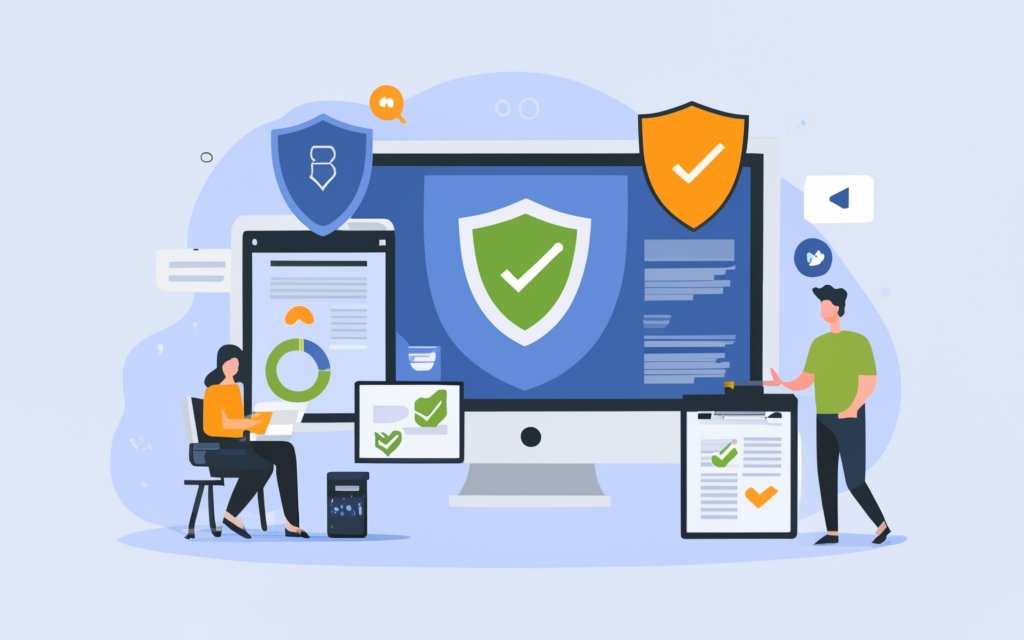
In today’s digital landscape, organizations of all sizes are migrating infrastructure and workloads to the cloud at an astonishing pace. As cloud adoption continues to accelerate, ensuring robust security, compliance, and identity management has become a top priority. This is where Microsoft’s Security, Compliance, and Identity Fundamentals (SC 900) certification comes into the picture.
In this comprehensive guide, we will explore everything you need to know about Microsoft’s SC-900 certification exam—from its core objectives to tips for Sc 900 exam preparation and beyond.
Understanding the SC 900 Exam Objectives
Microsoft designed the SC 900 exam to validate foundational knowledge across three key pillars:
- Security – Understanding core security concepts like defense-in-depth, Zero Trust framework, threat modeling, and more.
- Compliance – Navigating compliance requirements, data governance, auditing, and implementing controls.
- Identity – Securing identities, managing access, and protecting credentials.
Candidates appearing for the SC 900 exam should demonstrate aptitude in the following areas:
Describing Security, Compliance, and Identity Concepts
This objective tests your understanding of fundamental principles like CIA triad (Confidentiality, Integrity, Availability), Azure Shared Responsibility model, Zero Trust framework, and concepts like least privilege access, data encryption, threat modeling, and more.
You need to comprehend the relationship between security, compliance, and identity and how they complement each other in building robust cloud environments.
Understanding Capabilities of Microsoft Security Solutions
This covers the security services and features offered by Microsoft’s cloud platforms – primarily Microsoft 365 and Azure. Focus areas include threat protection capabilities, endpoint security, access controls, encryption technologies, logging/monitoring functionality, and more.
For instance, you should understand how solutions like Microsoft Defender, Azure Security Center, and Microsoft Sentinel help strengthen security posture.
Describing Capabilities of Microsoft Compliance Solutions
Here the focus shifts to Microsoft 365 and Azure capabilities that help meet organizational compliance requirements related to regulations, audits, and data governance.
Areas to study include data loss prevention, eDiscovery, retention policies, regulatory compliance offerings, Azure Policy, and tools like Microsoft Purview that enable compliance management.
Describing Capabilities of Microsoft Identity Solutions
Lastly, candidates must display knowledge of Microsoft identity and access management solutions like Azure Active Directory, Conditional Access, MFA, Privileged Identity Management, and credentials management.
You need to understand identity security concepts and how Azure AD helps authenticate identities, authorize access, and maintain visibility across the IT environment.
Who Should Take the SC 900 Exam?
Microsoft designed the SC 900 certification for a broad audience looking to enhance their cloud security skill sets. It has no formal prerequisites, making it an accessible entry point for various learner profiles:
- Business stakeholders – Executives, managers, directors involved in cloud adoption decisions for their organization.
- New IT professionals – Early-career IT admins, cloud engineers, security analysts looking to augment credentials.
- Existing IT pros – Experienced IT practitioners seeking to transition to security/compliance roles.
- Students – Undergrads/graduates interested in technology/cloud computing careers.
In summary, anyone looking for fundamental literacy of Microsoft security, compliance, and identity offerings can consider attempting the SC-900 exam. It serves as a stepping stone to associate or expert-level cybersecurity certifications.
Exam Registration and Policies
Let’s quickly run through some key details regarding SC 900 exam registration and policies:
- Cost – $99 USD. Regional pricing may vary.
- Format – Multiple choice and multiple response questions.
- Length – 100 minutes to complete 40-60 questions.
- Availability – English language only.
- Scoring – 700 points out of 1000 required to pass.
Make sure you schedule adequate preparation time once you register for the exam. Also, confirm system requirements to avoid any technical difficulties during the online proctored exam experience.
With the exam basics covered, let us now explore the core topics and skills tested in the SC-900 certification exam.
Section 1 – Describing Security, Compliance and Identity Concepts
This section tests your understanding of the fundamental principles and concepts relating to security, compliance, and identity management. Areas covered include:
Core Security Concepts and Methodologies
You should comprehend key concepts like:
- CIA triad
- Azure Shared Responsibility model
- Defense in Depth approach
- Zero Trust framework
- Least privilege access
- Role-based access control (RBAC)
Additionally, grasp basics of threat modeling, risk assessments, and common threats like DDoS attacks, malware, phishing, and social engineering.
Mapping Compliance Requirements
Learn fundamentals of regulatory compliance, including:
- GDPR, ISO standards, PCI DSS, and industry regulations.
- Data governance requirements around retention, transparency, residency, and privacy.
- Audits, risk assessments, and using compliance frameworks.
Identity and Access Management Concepts
Understand core identity concepts like:
- Authentication, authorization, and credential management.
- Multi-factor authentication and passwordless sign-in methods.
- Access reviews and privileged access management.
- Identity governance and admin roles.
With robust understanding of these fundamental concepts, you can optimize security, compliance, and identity implementations using Microsoft’s cloud solutions.
Section 2 – Understanding Microsoft Security Solutions
Microsoft offers industry-leading security technologies and services spanning endpoint, identity, network, application, and data security:
Microsoft security solutions
Figure 1 – Microsoft security solutions across Azure and Microsoft 365.
Let us explore some key security capabilities you need to know for the exam:
Microsoft 365 Security
- Microsoft Defender for Endpoint – Secures endpoints via antivirus, firewall, device controls, vulnerability management, and more.
- Microsoft Defender for Office 365 – Provides email and collaboration tools protection against malware, phishing, spam, and data exfiltration.
- Microsoft Defender for Identity – Leverages signals from Active Directory to identify sophisticated identity-based attacks.
- Microsoft Cloud App Security – Enables deeper visibility, data security, and threat protection for cloud applications.
Azure Security Services
- Azure Defender – Unified bundle of threat detection and protection for Azure resources.
- Azure Sentinel – Scalable SIEM and SOAR solution for alert detection, threat visibility, and security automation.
- Azure Key Vault – Centralized secrets management with access policies and audit history.
- Azure DDoS Protection – Protects Azure resources against DDoS attacks using traffic monitoring and real-time mitigation.
This section highlights Microsoft’s end-to-end security portfolio spanning endpoints, identity, network, applications, and data security. Familiarize yourself with these key offerings and their security capabilities targeting various attack vectors and breach scenarios.
Section 3 – Exploring Microsoft Compliance Solutions
Regulatory compliance is non-negotiable for most enterprises today. Microsoft provides integrated compliance solutions that interoperate with its cloud platforms – Microsoft 365 and Azure:
Microsoft compliance solutions
Figure 2 – Microsoft’s compliance management and assurance offerings
Let’s analyze some prominent Microsoft compliance features and offerings:
Microsoft 365 Compliance Capabilities
- Information Protection – Classify and label sensitive data using Azure Information Protection and secure document collaboration across Microsoft 365.
- Data Loss Prevention – Identify, monitor, and automatically protect sensitive information across Microsoft 365.
- eDiscovery tools – Search, collect, and export content across Exchange Online, SharePoint, OneDrive to support internal/legal investigations.
- Information Governance – Manage data lifecycle stages using retention labels and policies to automate retention, declaration, and disposal.
- Audit logs – Track user activities across Microsoft 365 services to meet compliance reporting needs.
Azure Compliance Offerings
- Azure Policy – Codify organizational standards and compliance requirements as policy definitions and monitor Azure resource configuration compliance.
- Azure Blueprints – Package policies, templates, security controls to rapidly deploy compliant environments.
- Regulatory Compliance offerings – 140+ compliance certifications covering global regulations like GDPR, ISO 27001, HIPAA etc.
- Microsoft Purview – Unified data governance solution providing data discovery, mapping, classification, and risk analysis.
Familiarity with these compliance capabilities will help you implement and demonstrate adherence to regulatory, industry, and organizational compliance standards using Microsoft 365 and Azure.
Section 4 – Describing Microsoft Identity Solutions
Microsoft’s identity and access management solutions centered around Azure Active Directory play a pivotal role in securing today’s hybrid and multi-cloud environments.
Microsoft Identity and Access Management Solutions
Figure 3 – Azure AD and complementary identity security products
Let’s analyze some key identity capabilities:
Azure Active Directory (Azure AD)
Azure AD serves as the primary identity and access management service across Microsoft 365, Azure, and hybrid environments. Core capabilities include:
- Authentication – Enable single sign-on (SSO) access to applications and resources for employees, business partners, and customers.
- Conditional Access policies – Context-based access controls combining signals like user identity, device compliance, geolocation etc.
- Privileged Identity Management – Manage and monitor privileged roles and Just-in-Time (JIT) access to mitigate insider threats.
- Identity Protection – Risk-based conditional access policies to automatically block suspicious sign-ins and remediate identity compromises.
Complementary Identity Security Services
- Multi-Factor Authentication (MFA) – Enforce an additional verification factor during sign-in events for security.
- Self-Service Password Reset – Users can reset passwords securely without engaging IT teams.
- Privileged Access Management – Granular access management for privileged roles like Global Admins, Exchange Admins etc.
- Identity Governance – Manage identity and access lifecycles through workflows like access reviews, attestations, and expiration.
These services collectively enable centralized visibility and control across the identity infrastructure to achieve end-to-end identity security, reduced risk surface, and improved productivity.
Section 5 – Preparing for the Microsoft SC-900 Exam
Now that you comprehend the exam objectives and topics, let’s discuss tips to prepare for the SC-900 certification test:
Study Resources
- Microsoft Learn SC-900 Learning Path – Free learning path covering all exam domains through modules and skills tests.
- Microsoft documentation – Explore technical docs for Microsoft 365 security, Azure security services, compliance management, and identity capabilities.
- Microsoft Virtual Training Days – Free training sessions across security, identity, compliance, and other topics led by subject matter experts.
- Testprep Training course – Structured video course and practice tests mapped with latest exam objectives.
Exam Preparation Tips
- Learn fundamentals – Thoroughly understand foundational concepts across security, compliance, and identity using the resources shared above.
- Attempt practice tests – Test knowledge gaps identifying areas needing further review.
- Read questions carefully – Analyze all presented details and avoid assumptions while answering situational questions.
- Manage exam time – The exam duration is 100 minutes for 40-60 questions, so pace responses accordingly.
- Get adequate sleep – Rest well the night before exam day to stay focused and think clearly during the assessment.
Using learning resources strategically and diligently preparing for a few weeks can help you succeed in earning the Microsoft SC-900 certification.
The Business Value of SC-900 Certified Professionals
The SC-900 certification validates cloud security fluency that organizations desperately need today. Let’s discuss a few career perks that newly certified professionals can enjoy:
- Augmented cloud security skills – Showcase fundamental knowledge of Microsoft security, compliance, and identity capabilities required in most IT roles today.
- Expanded job opportunities – Pursue careers like cloud security engineer, compliance auditor, risk advisor, security analyst, identity architect etc.
- Higher earning potential – Entry-level certifications open doors to lucrative cybersecurity and IT jobs with attractive compensation.
- Industry recognition – Globally trusted certification that grabs recruiter attention and provides competitive edge to candidates.
- Stepping stone for advanced certs – SC-900 serves as launch pad to associate and expert-level cybersecurity certifications.
The SC-900 credential offers long-term value even for seasoned IT professionals looking to pivot their skills and remain relevant in the cloud-first era.
Conclusion and Key Takeaways
We have covered significant ground in this comprehensive guide discussing Microsoft’s Security, Compliance and Identity Fundamentals certification.
Here are the key takeaways:
- The SC 900 exam tests core knowledge across security, compliance, and identity concepts including threat modeling, Azure Shared Responsibility, Zero Trust framework, data governance, authentication methods and more.
- It is an entry-level certification with no formal prerequisites, catering to IT newcomers, business decision makers, IT pros transitioning roles, and students.
- You need to demonstrate understanding of Microsoft 365 and Azure capabilities like Microsoft Defender, Azure Sentinel, information protection, conditional access policies, and Microsoft Purview.
- Recommended study resources include Microsoft Learn, exam prep courses, documentation, community forums, and practice tests.
- Earning the SC-900 certification opens doors to lucrative cybersecurity and cloud careers with globally recognized industry validation of baseline cloud security skills.
The SC-900 credential offers long-term value even for seasoned IT professionals looking to pivot their skills and remain relevant in the cloud-first era. With cloud adoption poised to continue rising exponentially, foundational literacy of Microsoft security and compliance solutions will be highly sought after.
Now is the time to skill up and get certified! We hope this guide has equipped you with the knowledge and tools to succeed in your SC-900 exam preparation journey. Stay motivated and believe in your abilities to grasp these critical concepts. With diligent practice using recommended study materials, you will be exam-ready in no time.
Best of luck with the Microsoft SC-900 certification exam! The entire cloud community looks forward to welcoming newly certified security, compliance and identity specialists.








